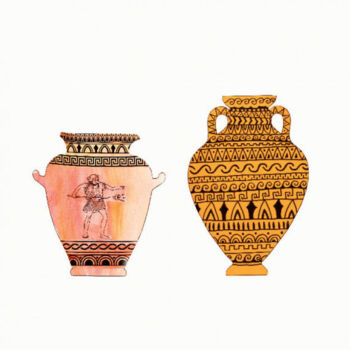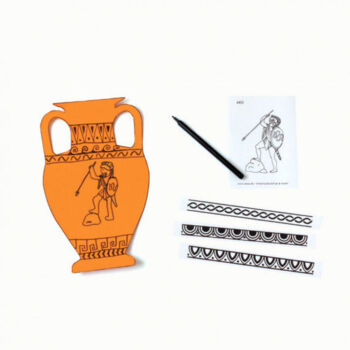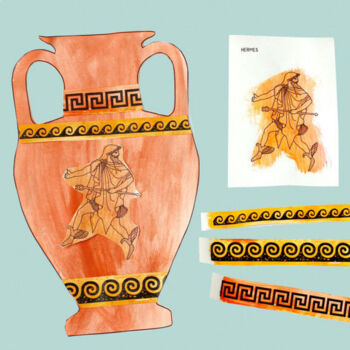Greek Gods & Vases: Templates for 16 Greek vases & 12 Greek god illustrations
- PDF
Description
Greek vases don’t only tell the stories of everyday life – they also tell the stories of heroes and gods. Most of the gods lived on Mount Olympus, the highest mountain in Greece. This material contains 12 of the most famous gods and goddesses: Zeus, Hera, Poseidon, Ares, Hermes, Apollo, Artemis, Athena, Hades, Aphrodite, Nike, Dionysus.
How to do it: Just select a vase shape and print it out. Then print out the god illustrations and meander motifs that you want to use. The vases look especially ‘Greek’ if you first paint them orange with poster paint A great group project is to glue lots of individual artworks together on a huge piece of paper to make a wall frieze.
Introduction
In order to form a picture of antiquity, knowledge of Greek vases is indispensable, since they show us what life in Athens and other Greek city-states looked like. These decorated vessels fulfilled several roles and had both practical and cultural importance. Scenes and themes from everyday life were often depicted, such as crafts people at work in their workshops, women in their domestic environment, trades people, athletic contests, and warriors in battle, to name just a few. The purpose of some of these vessels is also shown on them.
Shape and Use
The Greeks believed that the goddess Athena had invented the potter’s wheel. Many potters signed their vases, which is why we know today some of the names of the artists and crafts people who lived in those times. All types of vessel were painted – those for storage, meal times, religious rites, and festivals. Especially elaborately painted vessels were given as votive offerings to sanctuaries or placed in graves as burial gifts. The Greeks were perfectionists and not just content to make beautiful forms – functionality played just as big a role. A vessel’s handle should, for example, be comfortable to hold – every shape had to be perfect. There were vases and containers in every imaginable shape and size: Amphorae are bulbous, narrow-necked jugs with two handles, within which water, wine, oil, honey, and milk could be transported. Kraters were used to mix wine and water and hydria are bulbous water jugs that you could carry on your head or shoulder.
Ornamentation
Ornamentation was especially popular in Greek vase painting. They used triangles, circles, diamonds, zigzags, grids, wavy lines, and other characters. The most popular motif was the meander, which snakes back and forth across the landscape like a river. For the Greeks, this design symbolized the endless ups and downs of life.





